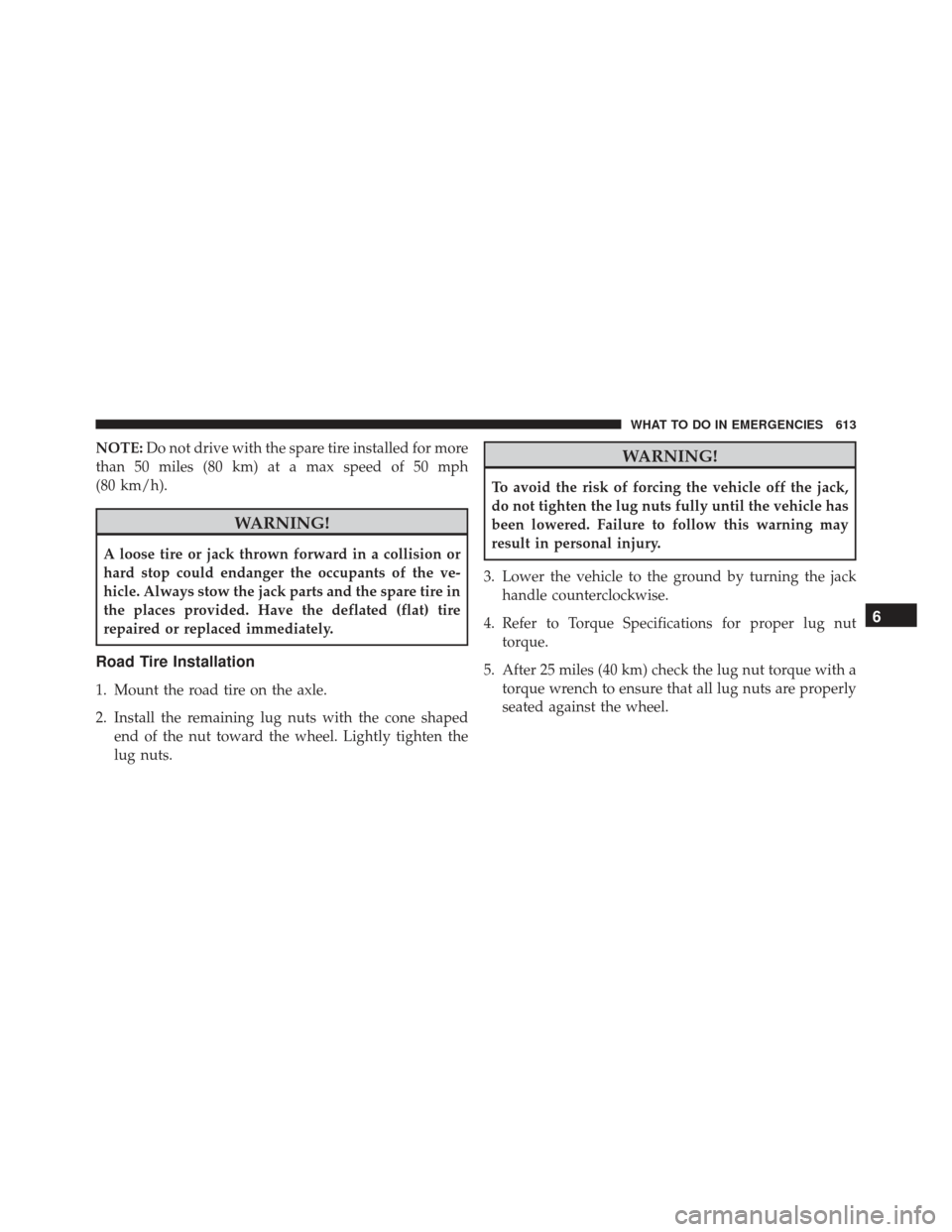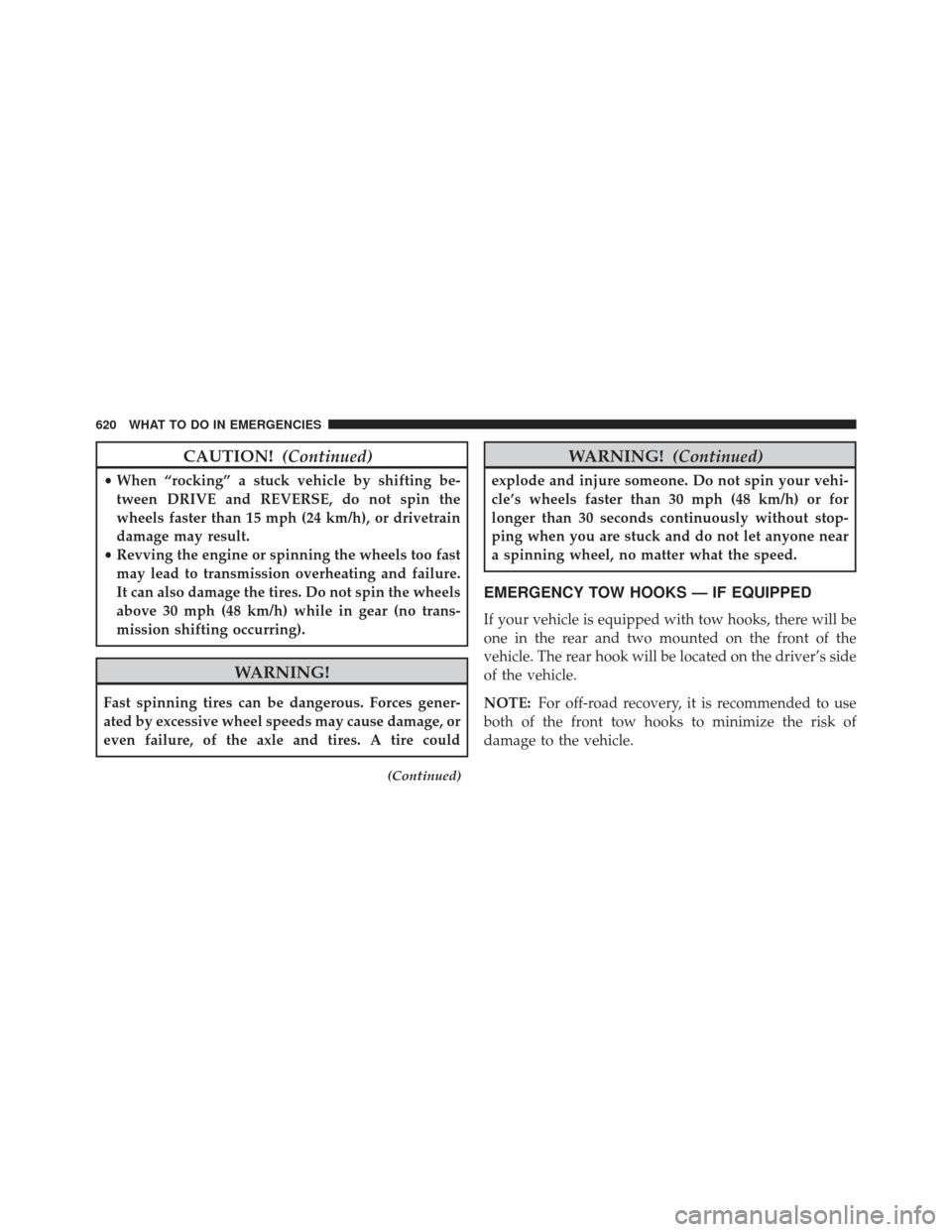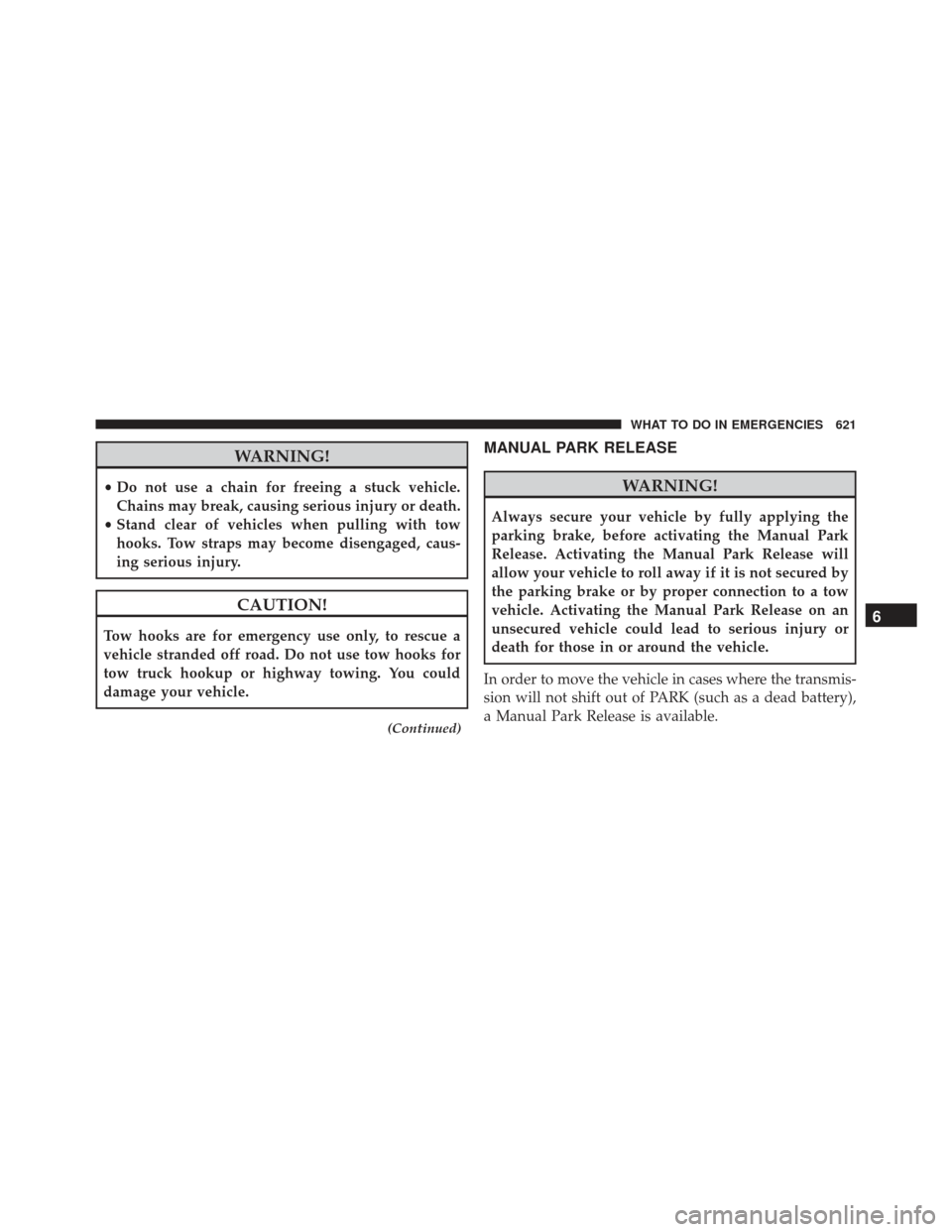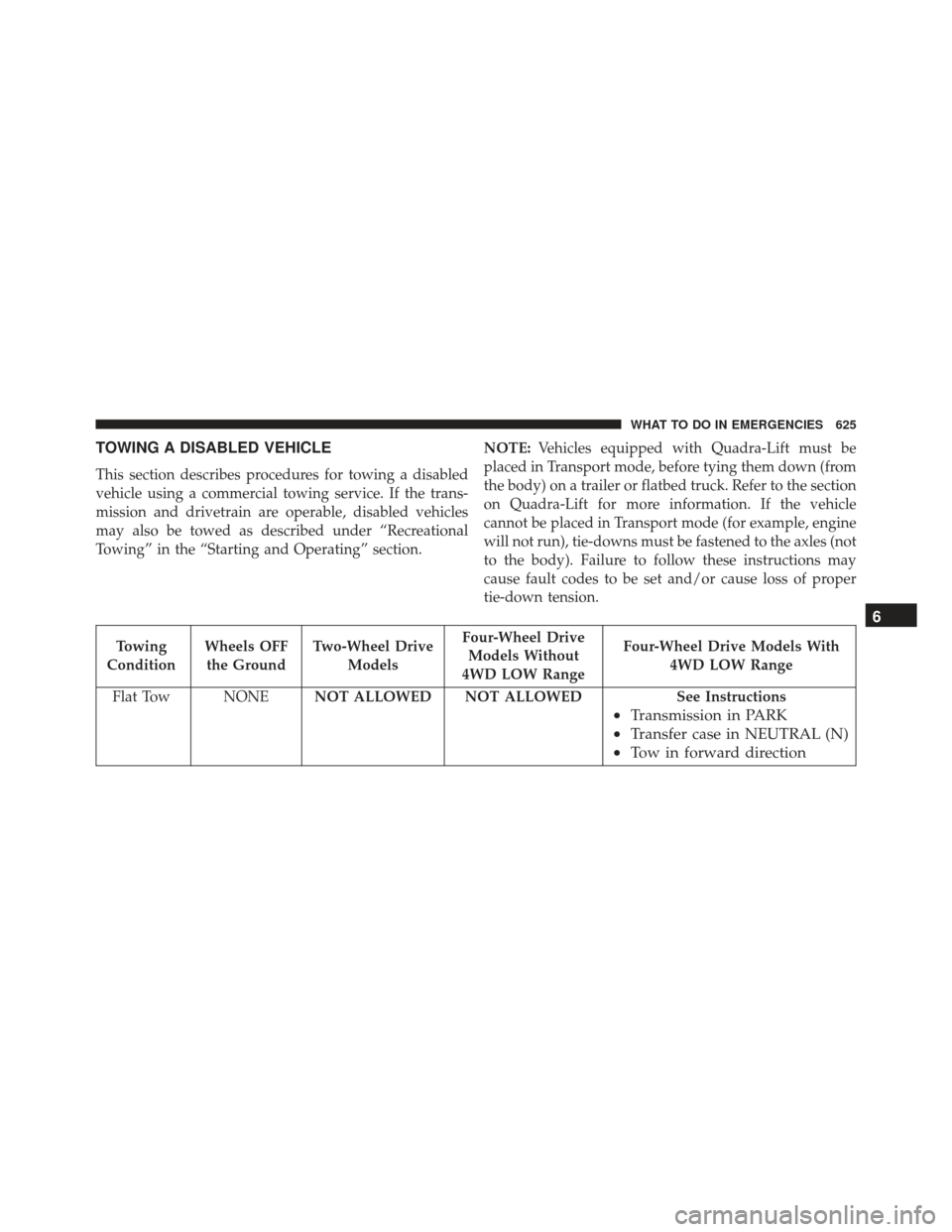Page 613 of 745
WARNING!
Raising the vehicle higher than necessary can make
the vehicle less stable. It could slip off the jack and
hurt someone near it. Raise the vehicle only enough
to remove the tire.
7. Remove the lug nuts and wheel.
8. Position the spare wheel/tire on the vehicle and install the lug nuts with the cone-shaped end toward the
wheel. Lightly tighten the nuts.
CAUTION!
Be sure to mount the spare tire with the valve stem
facing outward. The vehicle could be damaged if the
spare tire is mounted incorrectly.WARNING!
To avoid the risk of forcing the vehicle off the jack,
do not tighten the lug nuts fully until the vehicle has
been lowered. Failure to follow this warning may
result in serious injury.
Mounting Spare Tire
6
WHAT TO DO IN EMERGENCIES 611
Page 614 of 745

9. Lower the vehicle by turning the jack screw counter-clockwise, and remove the jack and wheel blocks.
10. Finish tightening the lug nuts. Push down on the wrench while at the end of the handle for increased
leverage. Tighten the lug nuts in a star pattern until
each nut has been tightened twice. For correct lug nut
torque refer to Torque Specifications in this section. If
in doubt about the correct tightness, have them
checked with a torque wrench by your authorized
dealer or at a service station.
11. Lower the jack to the fully closed position and return it and the tools to the proper positions in the foam
tray.
12. Remove the small center cap and securely store the road wheel in the cargo area. 13. Have the aluminum road wheel and tire repaired as
soon as possible, properly secure the spare tire with
the special wing nut torqued to 3.7 ft-lbs (5 N·m),
reinstall the jack and tool kit foam tray, and latch the
rear load floor cover.
Stowed Spare
612 WHAT TO DO IN EMERGENCIES
Page 615 of 745

NOTE:Do not drive with the spare tire installed for more
than 50 miles (80 km) at a max speed of 50 mph
(80 km/h).
WARNING!
A loose tire or jack thrown forward in a collision or
hard stop could endanger the occupants of the ve-
hicle. Always stow the jack parts and the spare tire in
the places provided. Have the deflated (flat) tire
repaired or replaced immediately.
Road Tire Installation
1. Mount the road tire on the axle.
2. Install the remaining lug nuts with the cone shaped end of the nut toward the wheel. Lightly tighten the
lug nuts.
WARNING!
To avoid the risk of forcing the vehicle off the jack,
do not tighten the lug nuts fully until the vehicle has
been lowered. Failure to follow this warning may
result in personal injury.
3. Lower the vehicle to the ground by turning the jack handle counterclockwise.
4. Refer to Torque Specifications for proper lug nut torque.
5. After 25 miles (40 km) check the lug nut torque with a torque wrench to ensure that all lug nuts are properly
seated against the wheel.
6
WHAT TO DO IN EMERGENCIES 613
Page 622 of 745

CAUTION!(Continued)
•When “rocking” a stuck vehicle by shifting be-
tween DRIVE and REVERSE, do not spin the
wheels faster than 15 mph (24 km/h), or drivetrain
damage may result.
• Revving the engine or spinning the wheels too fast
may lead to transmission overheating and failure.
It can also damage the tires. Do not spin the wheels
above 30 mph (48 km/h) while in gear (no trans-
mission shifting occurring).
WARNING!
Fast spinning tires can be dangerous. Forces gener-
ated by excessive wheel speeds may cause damage, or
even failure, of the axle and tires. A tire could
(Continued)
WARNING! (Continued)
explode and injure someone. Do not spin your vehi-
cle’s wheels faster than 30 mph (48 km/h) or for
longer than 30 seconds continuously without stop-
ping when you are stuck and do not let anyone near
a spinning wheel, no matter what the speed.
EMERGENCY TOW HOOKS — IF EQUIPPED
If your vehicle is equipped with tow hooks, there will be
one in the rear and two mounted on the front of the
vehicle. The rear hook will be located on the driver’s side
of the vehicle.
NOTE:For off-road recovery, it is recommended to use
both of the front tow hooks to minimize the risk of
damage to the vehicle.
620 WHAT TO DO IN EMERGENCIES
Page 623 of 745

WARNING!
•Do not use a chain for freeing a stuck vehicle.
Chains may break, causing serious injury or death.
• Stand clear of vehicles when pulling with tow
hooks. Tow straps may become disengaged, caus-
ing serious injury.
CAUTION!
Tow hooks are for emergency use only, to rescue a
vehicle stranded off road. Do not use tow hooks for
tow truck hookup or highway towing. You could
damage your vehicle.
(Continued)
MANUAL PARK RELEASE
WARNING!
Always secure your vehicle by fully applying the
parking brake, before activating the Manual Park
Release. Activating the Manual Park Release will
allow your vehicle to roll away if it is not secured by
the parking brake or by proper connection to a tow
vehicle. Activating the Manual Park Release on an
unsecured vehicle could lead to serious injury or
death for those in or around the vehicle.
In order to move the vehicle in cases where the transmis-
sion will not shift out of PARK (such as a dead battery),
a Manual Park Release is available.
6
WHAT TO DO IN EMERGENCIES 621
Page 624 of 745
Follow these steps to use the Manual Park Release:
1. Firmly apply the parking brake.
2. Open the center console and locate the Manual ParkRelease cover, remove it by snapping the cover away
from the console hinges. 3. Using a screwdriver or similar tool, push the metal
latch in towards the tether strap.
Manual Park Release Cover
Release Latch
622 WHAT TO DO IN EMERGENCIES
Page 626 of 745
To Disengage the Manual Park Release Lever:
1. To disengage the Manual Park Release apply tensionupward while pushing the release latch towards the
tether to unlock the lever. 2. Once the tension has been released and the lever has
been unlocked be sure it is stowed properly and locks
into position.
NOTE: Be sure to replace the cover by snapping it back
in place.
Release Latch
Stowed Position
624 WHAT TO DO IN EMERGENCIES
Page 627 of 745

TOWING A DISABLED VEHICLE
This section describes procedures for towing a disabled
vehicle using a commercial towing service. If the trans-
mission and drivetrain are operable, disabled vehicles
may also be towed as described under “Recreational
Towing” in the “Starting and Operating” section.NOTE:
Vehicles equipped with Quadra-Lift must be
placed in Transport mode, before tying them down (from
the body) on a trailer or flatbed truck. Refer to the section
on Quadra-Lift for more information. If the vehicle
cannot be placed in Transport mode (for example, engine
will not run), tie-downs must be fastened to the axles (not
to the body). Failure to follow these instructions may
cause fault codes to be set and/or cause loss of proper
tie-down tension.
Towing
Condition Wheels OFF
the Ground Two-Wheel Drive
Models Four-Wheel Drive
Models Without
4WD LOW Range Four-Wheel Drive Models With
4WD LOW Range
Flat Tow NONE NOT ALLOWED NOT ALLOWED See Instructions
•Transmission in PARK
• Transfer case in NEUTRAL (N)
• Tow in forward direction 6
WHAT TO DO IN EMERGENCIES 625